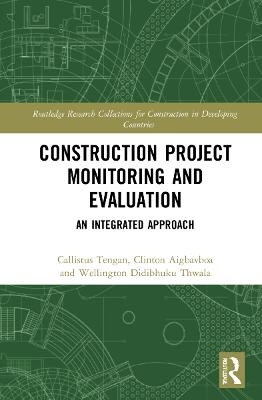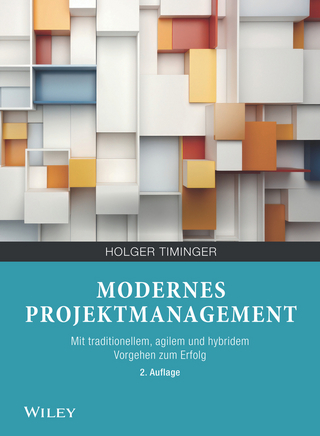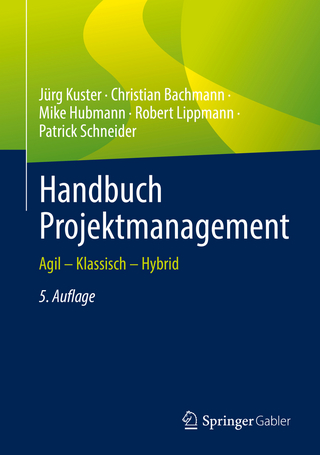
Construction Project Monitoring and Evaluation
Routledge (Verlag)
978-0-367-68529-4 (ISBN)
This book will provide readers with an in-depth theoretical awareness and practical guidance on the implementation of an effective monitoring and evaluation (M&E) system to ensure construction projects meet approved quality, cost, time and social sustainability objectives.
The authors discuss the drivers, challenges, determinants and benefits of effective M&E implementation together with the theories and models underpinning construction project M&E practices. Further, a comparative overview of M&E practices in developed and developing countries is presented to elucidate the best practices. The book first conceptualizes M&E as a five-factor model comprising stakeholder involvement, budgetary allocation and logistics, technical capacity and training, leadership, and communication. It then presents an M&E case study on the Ghanaian construction industry before expanding on the idea of M&E systems as an effective tool for project performance and in optimizing a project’s contribution to society and the environment.
The book further provides guidance on M&E practice for construction project managers, investors, professionals, researchers and other stakeholders and is therefore of interest to those in architecture, construction engineering, planning, project management and development studies.
Dr. Callistus Tengan is a Senior Lecturer in the Department of Building Technology at Bolgatanga Technical University, Ghana and a Professional member of the Ghana Institution of Surveyors (GhIS). He is a Postdoctoral Research Fellow in the Department of Construction Management and Quantity Surveying of the University of Johannesburg, South Africa. Professor Clinton Aigbavboa is the Director of the CIDB Centre of Excellence & Sustainable Human Settlement and Construction Research Centre, Faculty of Engineering and the Built Environment, University of Johannesburg, South Africa. Professor Wellington Didibhuku Thwala is the Director of the South Africa Research Chair in Sustainable Construction Management and Leadership in the Built Environment, Faculty of Engineering and the Built Environment, University of Johannesburg, South Africa.
PART 1
Performance management and measurement 1
1 Project management 3
1.1 Abstract 3
1.2 Introduction 3
1.3 Project performance management 4
1.4 Monitoring and evaluation as a performance management tool 4
1.5 Emerging trends in project monitoring and evaluation 5
1.5.1 Drone and unmanned aerial vehicles (UAVs) 6
1.5.2 Building information modelling (BIM) 6
1.5.3 Geographic information system (GIS) 7
1.6 Professional ethics in the construction industry 7
1.7 Aim of the book 8
Summary 9
References 9
2 Overview of project monitoring and evaluation research 12
2.1 Abstract 12
2.2 Introduction 12
2.2.1 Monitoring 12
2.2.1.1 Types of monitoring 13
2.3 Evaluation 14
2.3.1 Types of evaluation 17
2.3.2 Need for evaluation 18
2.4 Monitoring and evaluation 18
2.5 Approach, methods, tools and techniques of M&E 20
2.6 Monitoring and evaluation indicators 23
2.7 Types of monitoring and evaluation indicators 24
2.8 Benefits of effective monitoring and evaluation 25
2.9 Challenges to monitoring and evaluation 26
2.9.1 Organizational-level challenges 26
2.9.2 Project-based challenges 27
2.9.3 Technical-based challenges 27
Summary 29
References 29
3 Monitoring and evaluation system and framework 33
3.1 Abstract 33
3.2 Introduction 33
3.3 Logical framework 34
3.4 Results framework 36
3.5 Conceptual or narrative framework 37
3.6 Steps in developing a monitoring and evaluation framework 38
3.7 A monitoring and evaluation system 39
3.8 Types of a monitoring and evaluation system 41
3.8.1 Implementation-focused M&E system 41
3.8.2 Results-based M&E system 41
3.9 Criteria for assessing the quality of a monitoring
and evaluation system 42
3.10 Steps in developing a monitoring and evaluation system 43
3.11 Components of a monitoring and evaluation system 45
3.11.1 Category one 45
3.11.2 Category two 47
3.11.3 Category three 47
3.12 A monitoring and evaluation plan 47
Summary 48
References 48
PART 2
Theories, models and concepts in monitoring and evaluation research 51
4 Theories of monitoring and evaluation 53
4.1 Abstract 53
4.2 Introduction 53
4.3 Monitoring and evaluation theory defined 54
4.4 A review of monitoring and evaluation theories 54
4.4.1 The evaluation theory 55
4.4.1.1 The evaluation theory tree 55
4.4.1.2 Method perspective 57
4.4.1.3 Value perspective 58
4.4.1.4 Use perspective 58
4.5 Theory of change 59
4.6 Program theory 60
Summary 61
References 62
5 Monitoring and evaluation models 64
5.1 Abstract 64
5.2 Introduction 64
5.3 Classification of evaluation models 64
5.3.1 Evert Vedung’s classification 64
5.3.2 Stufflebeam’s classification 65
5.3.3 Evaluation approaches for the 21st Century 65
5.3.4 Stufflebeam’s context, input, process and
product (CIPP) model 65
5.3.5 Scriven’s goal-free evaluation model 66
5.3.6 Stake’s responsive evaluation model 67
5.3.7 Patton’s utilization-focused evaluation model 67
5.3.8 Guba’s ethnographic evaluation model 67
Summary 68
References 68
6 Conceptual IME model for construction project delivery 69
6.1 Abstract 69
6.2 Introduction 69
6.3 Key determinants of effective monitoring and evaluation 71
6.3.1 Stakeholder involvement 73
6.3.2 Budgetary allocation 74
6.3.3 Technical capacity and training 75
6.4 Proposed IME conceptual model 76
6.5 Theoretical underpinning of the conceptual model 77
6.6 Structural components and specification
of the conceptual IME model 77
6.7 IME model justification 78
Summary 80
References 81
PART 3
Communication and leadership in monitoring and evaluation 85
7 Aspects of communication in monitoring and evaluation 87
7.1 Abstract 87
7.2 Introduction 87
7.3 Understanding monitoring and evaluation communication 88
7.3.1 Types of communication 89
7.3.1.1 Intrapersonal communication 90
7.3.1.2 Interpersonal communication 90
7.3.1.3 Mass communication 91
7.3.1.4 Group communication 91
7.3.2 Communication models 91
7.3.2.1 Shannon and Weaver’s model of communication, 1948 92
7.3.2.2 Lasswell’s model of communication, 1948 92
7.3.2.3 Osgood-Schramm’s model of communication 93
7.3.2.4 Aristotle’s model of communication 94
7.3.2.5 David Berlo’s S-M-C-R model of communication 94
7.4 Functions of communication in monitoring and evaluation 95
7.4.1 Information sharing and awareness creation 96
7.4.2 Education and training 96
7.4.3 Persuasion 97
7.5 The use of information communication technology (ICT) in construction project monitoring and evaluation 97
7.6 Benefits of monitoring and evaluation communication 98
7.7 Barriers to monitoring and evaluation communication 99
7.8 Achieving effective monitoring and evaluation communication 100
Summary 102
References 102
8 Perspectives in monitoring and evaluation leadership 106
8.1 Abstract 106
8.2 Introduction 106
8.3 Types of leadership styles 108
8.3.1 Transformational leadership style 108
8.3.2 Transactional leadership style 109
8.3.3 Autocratic/authoritative leadership style 109
8.3.4 Democratic or participatory leadership style 109
8.3.5 Laissez-faire leadership style 110
8.3.6 Bureaucratic leadership style 110
8.3.7 Charismatic leadership style 111
8.4 Leadership theories: An evolution tree approach 111
8.4.1 Personality era 111
8.4.2 Influence era 113
8.4.3 Behavior era 113
8.4.4 Situation era 114
8.4.5 Contingency era 114
8.4.6 Transactional era 115
8.4.7 Anti-leadership era 115
8.4.8 Culture era 115
8.4.9 Transformational era 116
8.5 Barriers to effective monitoring and evaluation leadership 116
8.6 Achieving effective monitoring and evaluation leadership 118
Summary 119
References 119
PART 4
Country perspective on monitoring and evaluation practices 125
9 Monitoring and evaluation in developed countries: A global view 127
9.1 Abstract 127
9.2 Introduction 127
9.3 Overview of the United Kingdom construction industry 129
9.4 Overview of the Australian construction industry 129
9.5 Philosophical basis and policy for monitoring and evaluation in the United Kingdom and Australia 130
9.6 Monitoring and evaluation in the public sector 132
9.7 Monitoring and evaluation policy challenges in developed countries 133
9.8 Findings and lessons learnt 134
Summary 134
References 134
10 Monitoring and evaluation in developing countries: An African experience 136
10.1 Abstract 136
10.2 Introduction 136
10.3 Monitoring and evaluation in Africa 136
10.4 Kenya 137
10.4.1 Construction industry outlook of Kenya 137
10.4.2 Monitoring and evaluation regulatory policy in Kenya 139
10.4.3 Construction project monitoring and evaluation in Kenya 140
10.4.4 Challenges in construction project monitoring and evaluation in Kenya 140
10.4.5 Findings and lessons learnt from Kenya 141
10.5 South Africa 141
10.5.1 Construction industry outlook of South Africa 142
10.5.2 Monitoring and evaluation regulatory policy in South Africa 143
10.5.3 Municipal infrastructure project implementation and M&E in South Africa 145
10.5.4 The South African Construction Industry Development Board 145
10.5.5 Challenges in construction project monitoring and evaluation in South Africa 147
10.5.6 Findings and lessons learnt from South Africa 148
Summary 149
References 149
11 A review of the Ghanaian construction industry and the practice of monitoring and evaluation 152
11.1 Abstract 152
11.2 Introduction 152
11.3 Overview of the Ghanaian construction industry 153
11.3.1 Significance of the Ghanaian construction industry 154
11.3.2 Challenges of the Ghanaian construction industry 156
11.3.2.1 Industry challenges 156
11.3.2.2 Economic challenges 157
11.3.2.3 Project management and implementation challenges 157
11.4 Construction project monitoring and evaluation
practice in Ghana 159
11.4.1 Project management consultants 160
11.4.2 Ministry of water resources works and housing
(MWRWH) 161
11.4.3 Ghana Education Trust Fund (GETFund) 161
11.4.4 Metropolitan, municipal and district assemblies
(MMDAs) 162
11.5 Monitoring and evaluation regulatory policy in Ghana 163
11.6 Implementation of monitoring and evaluation systems
in the Ghanaian construction industry 165
11.6.1 Site visit and inspection (supervision) 165
11.6.2 Site meeting 166
11.6.3 Progress reporting 166
11.7 Stakeholders involved in M&E in the Ghanaian construction industry 167
11.8 Barriers to effective construction project monitoring and evaluation implementation in Ghana 168
11.9 Knowledge management in the monitoring and evaluation of projects 169
Summary 169
References 170
PART 5
Insight from Delphi research study: A case of Ghanaian experts 175
12 Case study 177
12.1 Abstract 177
12.2 Introduction 177
12.3 Demographic characteristics of experts 179
12.4 Delphi-specific objectives 179
12.4.1 The need for and relevance of M&E in the Ghanaian construction industry 180
12.4.2 The main factors and sub-attributes that determine effective M&E in the Ghanaian construction industry and its relationship with M&E determinants in other countries 182
12.4.3 Critical challenging factors that influence M&E in the Ghanaian construction industry 188
12.4.4 Impact of effective M&E determinants on the success of project delivery in the GCI 189
Summary 190
References 190
| Erscheinungsdatum | 28.04.2021 |
|---|---|
| Reihe/Serie | Routledge Research Collections for Construction in Developing Countries |
| Zusatzinfo | 19 Tables, black and white; 20 Line drawings, black and white; 4 Halftones, black and white; 24 Illustrations, black and white |
| Verlagsort | London |
| Sprache | englisch |
| Maße | 156 x 234 mm |
| Gewicht | 444 g |
| Themenwelt | Technik ► Bauwesen |
| Wirtschaft ► Betriebswirtschaft / Management ► Projektmanagement | |
| ISBN-10 | 0-367-68529-9 / 0367685299 |
| ISBN-13 | 978-0-367-68529-4 / 9780367685294 |
| Zustand | Neuware |
| Informationen gemäß Produktsicherheitsverordnung (GPSR) | |
| Haben Sie eine Frage zum Produkt? |
aus dem Bereich


